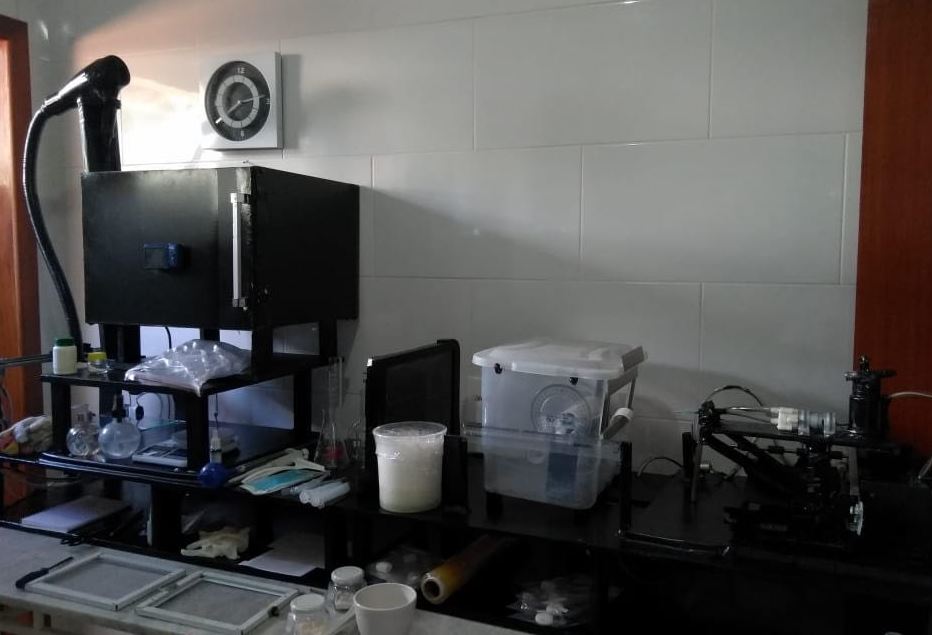Device/prototype production of synthetization of scaffolds the base of fibroin and Aloe barbadensis
DOI:
https://doi.org/10.20873/jbb.uft.cemaf.v8n1.cortelettiKeywords:
device, tissue engineering, scaffoldsAbstract
This research established itself as principle the building of a device/prototype specific for synthesis of scaffolds composed of gel Aloe barbadensis Miller and fibroin extracted from cocoons of Bombyx mori, elaborate in favor of the development of equivalents dermo-epidermal. Consisting of an experimental study, with materials selection and related equipment, projection and construction of a prototype aiming at processing on larger scale and the best cost-benefit ratio, making the final product more accessible for those who need.In this way,the development of the device/prototypewas carried outnoting his performance in the process,being necessarythe conducting analyses physicochemical and microbiological of the scaffolds produced.
References
Ahsan T, Nerem RM. Bioengineered tissues: the science, the technology, and the industry. Orthodontic & Craniofacial Clinical and Translational Research. v.8, n.3, p134-140, 2005.
https://doi.org/10.1111/j.1601-6343.2005.00326.x
Chan BP, Leong KW. Scaffolding in tissue engineering: gen-eral approaches and tissue-specific considerations. European Spine Journal. v.17, n.4, p467-479, 2008.
https://doi.org/10.1007/s00586-008-0745-3
Chan G, Mooney DJ. New materials for tissue engineering: towards greater control over the biological response. Trendsin Biotechnology. v.26, n.7, p382-392, 2008.
https://doi.org/10.1016/j.tibtech.2008.03.011
Ma D, Wang Y, Dai W. Silk fibroin-based biomaterials for musculoskeletal tissue engineering.Materials Science and Engineering. v.89, n.1, p456-469, 2018.
https://doi.org/10.1016/j.msec.2018.04.062
Ma PX. Scaffolds for tissue fabrication. Materials Today. v.7, n.5, p30-40, 2004.
https://doi.org/10.1016/S1369-7021(04)00233-0
Moroni L, Elisseeff JH. Biomaterials engineered for integra-tion. Materials Today. v.11, n.5, p44-51, 2008.
https://doi.org/10.1016/S1369-7021(08)70089-0
O'Brien FJ. Biomaterials & scaffolds for tissue engineering. Materials Today. v.14, n.3, p88-95, 2011.
https://doi.org/10.1016/S1369-7021(11)70058-X
Polak DJ. Regenerative medicine. Opportunities and challeng-es: a brief overview. Journal of the Royal Society. v.7, n.6, p777-781, 2010.
https://doi.org/10.1098/rsif.2010.0362.focus
Rodrigues BFFS. Engenharia de tecidos para regeneração da pele: retrospectiva e perspectivas futuras. Ano de obtenção: 2012. 68p. Dissertação (Mestrado Integrado em Ciências Farmacêuticas) – Universidade Fernando Pessoa, Porto.
Sachlos E, Czernuszka JT. Making Tissue Engineering Scaf-folds Work. Review: The application of solid freeform fab-rication technology to the production of tissue engineering scaffolds. v.5,p29-40, 2003.
https://doi.org/10.22203/eCM.v005a03
Turnbull G, Clarke J, Picard F, Riches P, Jia L, Han E, Li B, Shu W. 3D bioactive composite scaffolds for bone tissue engineering. Bioactive Materials. v.3, n.3, p278-314, 2018.
https://doi.org/10.1016/j.bioactmat.2017.10.001
Vunjak-Novakovic G, Kaplan DL. Tissue Engineering: The Next Generation. Tissue Engineering. v.12, n.12, p.3261-3263, 2006.
https://doi.org/10.1089/ten.2006.12.3261
Yildirimer L, Thanh NTK, Seifalian AM. Skin regeneration scaffolds: a multimodal bottom-up approach. Trends in Bio-technology. v.30, n.12, p.638-648, 2012.
https://doi.org/10.1016/j.tibtech.2012.08.004
Zhang Z, Gupte MJ, Ma PX. Biomaterials and stem cells for tissue engineering. v.13, n.4, p.527-540, 2013.

Published
How to Cite
Issue
Section
License
Copyright (c) 2024 - Journal of Biotechnology and Biodiversity

This work is licensed under a Creative Commons Attribution 4.0 International License.
Authors who publish with this journal agree to the following terms:
Authors retain copyright and grant the journal right of first publication with the work simultaneously licensed under a Creative Commons Attribution License (CC BY 4.0 at http://creativecommons.org/licenses/by/4.0/) that allows others to share the work with an acknowledgement of the work's authorship and initial publication in this journal.
Authors are able to enter into separate, additional contractual arrangements for the non-exclusive distribution of the journal's published version of the work (e.g., post it to an institutional repository or publish it in a book), with an acknowledgement of its initial publication in this journal.
Authors are permitted and encouraged to post their work online (e.g. in institutional repositories or on their website) prior to and during the submission process, as it can lead to productive exchanges, as well as earlier and greater citation of published work (Available at The Effect of Open Access, at http://opcit.eprints.org/oacitation-biblio.html).


